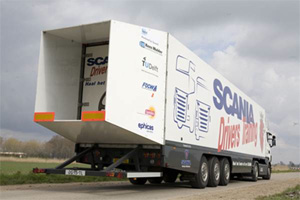Nov 9 2009
A boat tail, a tapering protrusion mounted on the rear of a truck, leads to fuel savings of 7.5 percent. This is due to dramatically-improved aerodynamics, as shown by road tests conducted by the PART (Platform for Aerodynamic Road Transport) public-private partnership platform.
 Boat Tail on a truck
Boat Tail on a truck
Public highways
A boat tail is a tapering protrusion about two metres in length mounted on the rear of a truck. The boat tail had already proved itself during wind tunnel experiments and computer simulations, both conducted at TU Delft, in theory and using small-scale models. Now an articulated lorry fitted with a boat tail has also undergone extensive testing on public highways.
Boat tail
Emissions
An articulated lorry was driven for a period of one year with a boat tail (of varying length) and one year without a boat tail. The improved aerodynamics, depending on the length of the boat tail, resulted in reduced fuel consumption (and emissions!) of up to 7.5 percent. The optimum boat tail length proved to be two metres.
PART
The tests were conducted by PART. This is a platform in which academics, road transport manufacturers, transport companies and shippers work together. The platform aims to reduce fuel consumption in the road transport industry by improving aerodynamics. PART’s ambition is to achieve a 20 percent reduction in fuel consumption and CO2 emissions in the road transport industry by 2020. TU Delft acts as secretary of PART. PART has previously conducted road tests on a new generation of aerodynamic sideskirts, which are to make their commercial debut later this year.